Table of contents
- Deserts of the earth Motorcycling at the limit
- Interview with Michael Martin
- Deserts of the earth (info)
- Deserts of the earth (2)
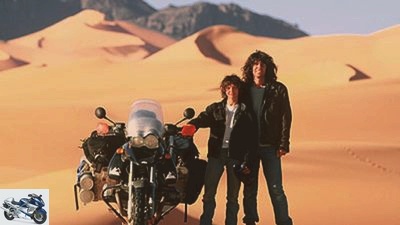
Martin
to travel
Deserts of the earth
Deserts of the earth
Motorcycling at the limit
Photographer Michael Martin took five years to realize his new project: to experience all of the world’s deserts on a motorcycle. Part 1 of the three-part report leads through Arabia, Asia and Australia.
Michael Martin
10/08/2004
For a moment, the holiday mood arises. The stress of months of travel preparation, saying goodbye to our families, the drifting snow on the journey from Munich to Venice – all of this fades into the background when the ferry leaves for Turkey. Elke and I are once again studying the map of the world that we have spread out on the floor of our cabin: A third of the earth’s surface are deserts and semi-deserts, scattered over more than 50 countries. We took five years to traverse them all. 100,000 kilometers lie ahead of us.
The stages through Syria and Jordan serve to get used to the driving characteristics of the basically completely overloaded BMW R 1150 GS, which sometimes comes across like a drunk donkey. Nevertheless, things are making good progress, even on the sandy slopes in Wadi Rum. Then the first major setback. In Amman we are chased away from the yard of the Saudi Arabian embassy like stray dogs. It is not even possible to get a transit visa for the desert state on site. We seek advice from the German embassy and get the tip that the passport photos must show Elke in a veiled manner. So off to the photo studio, headscarf instead of helmet. Elke looks like a nun – but we also fail the second attempt at the embassy porter. Saudi Arabia remains closed. Fortunately, there are enough ships in the port of Aqaba that circumnavigate the country and head for Yemen via the Red Sea.
Passing Sanaa, which is considered the oldest and most beautiful city in the Arab world with its residential castles made of clay, we arrive at Marib. The further route from there through the desert to Wadi Hadramaut leads through risky areas. The local tribes blackmail the government by kidnapping foreigners. But you can take precautions: We are secretly recommended to pay the local sheik a protection money. A whopping 600 US dollars change hands, and from now on his men are more or less protecting us from themselves. Flanked by two cars, we cover the 400 kilometers through the tribal area without incident. In the end, we even got used to the ubiquitous Kalashnikovs.
Buy complete article
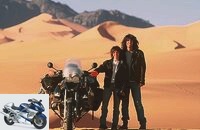
Deserts of the earth
Motorcycling at the limit
16 pages) as PDF
€ 2.00
Buy now
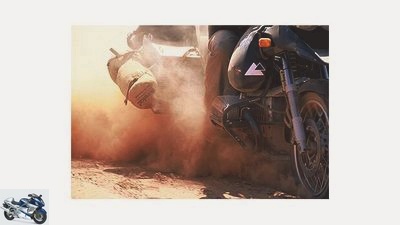
Martin
Dust and dryness are constant companions on the long tour.
Change of location. We travel by ferry from the Arabian Peninsula to Iran, aiming for the Lut desert, one of the hottest and driest regions in the world. The two motorcyclists with whom we share the night camp are on their way from Afghanistan to Turkey – smugglers who are carrying kilos of hashish and opium in their panniers.
The next destination is the Karakum (“black desert”) and Kysilkum (“red desert”) deserts in Central Asia. The former takes up the majority of the area of Turkmenistan, a state that seals itself off in a similar way to North Korea. With a lot of luck we got a visa and are now traveling in the realm of President Nijasow, who has a bizarre cult of ego. Everywhere he is immortalized in golden statues, even vodka bottles bear his likeness.
Between Karakum and Kysilkum in Uzbekistan lies the Aral Sea, once the fourth largest inland body of water in the world. Until the Soviet planned economies began to use the tributaries to irrigate cotton and rice fields. Today its volume is only a fifth of the original amount – where water used to glisten, we dust over absolutely dead land. A former captain shows us his ship, which like many others lies on dry land in the former port of Moynak.
We approach the Chinese border via Samarkand and Almaty in Kazakhstan. We already took care of the formalities to be able to enter the Middle Kingdom with our own vehicle at home: A Chinese driver’s license and registration including number plate must be available at the border. In addition, there is a guide in the off-road vehicle who will not leave us until we leave.
In Urumqui we visit Li Wenhua, the woman who spent months trying to get our permits. From here the route leads through the monotonous Beijan desert. In the middle of the loneliness we meet a hiker who is on his way to the communist party congress in Beijing as a kind of political token of love – in six months he has covered around 1500 kilometers, 3510 are still ahead of him.
Interview with Michael Martin
How many slides did Michael Martin take in the deserts of the earth? and why is he sleeping outside in the garden?
You took five years to travel the deserts of the world. Please give us a few facts and figures. How many countries? How many kilometres? How many movies?
Elke Wallner and I have traveled to 50 countries on all continents. We spent around 100,000 kilometers in the saddle of our BMW R 1150 GS and exposed around 2,200 films (36 photos each correspond to 79,200 slides; editor’s note). The selection of images for the lecture and the illustrated book was hard work after each stage.
Why are you always drawn to desert areas?
I love to be out in deserts. This type of landscape is so incredibly varied. Sometimes dangerous, sometimes romantic. And desert travel is always a challenge. As a photographer, I also like the colors and shapes, and I also appreciate the people who have learned to survive in these sometimes extremely hostile areas. Something like that shapes very strong personalities.
Your motorcycle looks completely overloaded. Plus Elke as a partner. Wouldn’t a car be a better vehicle for such a company?
In principle, yes, especially if you have to take photos and film on the side. Often we were so exhausted from driving that we hardly had the strength to pick up the cameras. Other problems are range and payload – both of which are actually not enough. Nevertheless, the motorcycle always represents an ideal bridge to people. It doesn’t matter when we met – because of the motorcycle, we were received extremely friendly practically everywhere. Even the otherwise very strict Chinese customs officers were very courteous and interested when we arrived. In addition, motorcycling in the desert is simply fun.
A month-long slide show tour, your new photo book, the film and other publications – that sounds like a lot of work. Would you tackle such a huge project again? And if so – which one?
Yeah, it’s a hell of a lot of work. But I am supported by a good team, sponsors help with the financing, and I have 20 years of experience in this business. All in all, “The Deserts of the Earth” will have occupied us for ten years: five years of travel and five years of evaluation. I don’t yet know what comes next. Definitely desert again!
Where does Michael Martin actually spend his vacation?
It looks bad at first. After the first winter of the tour, Elke and I will fly south with our children during the Easter holidays, probably to Italy – and definitely without a camera! But Elke and I already lack the travel, the feeling of always being on the move, of discovering something new. Because we got so used to our nomadic way of life, we later slept in our sleeping bags outside in the garden practically every night at home in the summer.
Deserts of the earth (info)
Long-distance travel has a very special charm. Planning such a project, on the other hand, can be daunting. A few tips from the so-called sewing box of the professional can make the first organizational steps easier.
Documents
Traveling to the regions described in the text requires extensive preparation, whereby the procurement of all visas, for example for the Central Asian countries, is still the least problem: all entry permits (information on this at www.auswaertiges-amt.de) can be obtained from the visa Central in Berlin. There are 18 euros or more per stamp. Information under phone 030/230959110; www.visum-centrale.de. Entering China and Tibet with your own vehicle is much more difficult. A Chinese driver’s license, a Chinese vehicle registration plus license plate and a state-recognized driver are required. To do this, you have to contact the Chinese employees of the China International Travel Service (CITS), who can be reached via the Tourist Office of the People’s Republic of China, phone 069/520135. More, countless travel information and links can be found on the Internet if you enter the term »China Travel« into a search engine. However, one or two motorcycle travelers have managed to penetrate the Middle Kingdom entirely without a visa and escort. Recently, two guys from Wildau succeeded in doing this. They drove on their XTs along an extremely adventurous route to Shanghai and back for a year (www.lomo-expedition.de). The administrative stuff for Australia, on the other hand, is hardly worth mentioning: an application for a visa is available in every travel agency.
Motorcycle transport
All Central Asian countries as well as Pakistan and China can in principle (and with enough time!) Be reached by land. As I said – in principle. With less time, you have to send your motorcycle to the desired destination – a good starting point for a trip through this part of the world is, for example, Almaty in Kazakhstan. Unfortunately, such transports by rail have practically been discontinued. So there is no getting around air freight. Information: Bikeworld Travel (phone 05231/580262; www.bikeworld-travel.de) or GS-Sportreisen (phone 089/27818484; www.gs-sportreisen.de). Both companies of course also ship a motorcycle to Australia (and the rest of the world). Sea freight is often an alternative, although not always cheaper and sometimes significantly more complicated than air. Information: MBS-Sea-Cargo (phone 02203/933842, also air transport) or the travel agency Hamburg-Sud (phone 040/37052593).
literature
Anyone planning a long-haul trip should definitely take a look at the “Self-Travel Manuals” from the German Central for Globetrotters from Peter Meyer Verlag (www.petermeyerverlag.de). “Volume 1: For travel preparation” (535 pages, 14.95 euros) deals in great detail and in an extremely practical manner with everything that needs to be done in advance, while “Volume 2: For traveling” (256 pages, 12.95 Euros) has a lot of practical tips ready for difficulties during the tour.
security
When Michael Martin and Elke Wallner set out on the first leg of their journey to the Arab world and Central Asia in 1999, the world was different when it came to security. In the meantime, kidnapped tourists in Yemen, the Sahara and Iran, bomb attacks on Djerba, Malaysia or in Tashkent in Uzbekistan (July 2004) and, last but not least, the generally politically unstable situation in the Near and Middle East have deterred many travel fans from trips to these regions . In addition, the Federal Foreign Office (www.auswaertiges-amt.de) explicitly warns against traveling to several Arab and Central Asian countries (Uzbekistan, some areas in Kyrgyzstan and Iran as well as Pakistan). Religiously motivated clashes and assaults as well as targeted attacks on Western foreigners and institutions in the background of the US operations in Afghanistan have increased sharply. Unfortunately, traveling in these countries is now associated with an incalculable risk, and you should inquire about the current situation at the beginning of the trip. Useful information can usually be found in the corresponding Internet forums: www.sahara-forum.de, www.sahara-info.ch or www.horizonsunlimited.com. Travel professional Michael Martin does not perceive the current situation as extremely threatening – he would choose the same route again today as at the beginning of his desert project: “On our travels in Arab countries, we only ever met people who really had nothing in mind with militant fundamentalism . Hospitality is absolutely sacred to these peoples. One should not draw false or hasty conclusions from the media reports. “
Deserts of the earth (2)
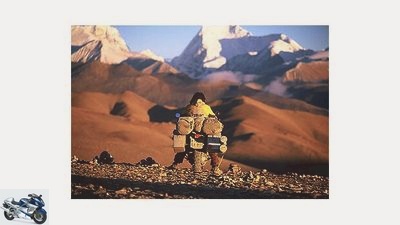
Martin
Out and about with the motorized donkey, a BMW R 1150 GS.
Our route leads first into the Alashan, then across the Yellow River into the Quaidam desert. In the middle of this high desert, which is already part of the Tibetan culture, lies the holy lake Koko Nur, which countless pilgrims walk around for days. Recently, two men had simplified themselves and had ridden the 200 kilometers on a motorcycle. Our first contact with the Tibetan way of life fascinates us completely.
Unfortunately, we do not have permission to travel to Tibet from here. So we keep along the southern foothills of the mighty Takla Makan to the Kashgar oasis, one of the most important junctions along the historic Silk Road, where trade is still boiling today as it was in Marco Polo’s time.
We leave China over the 4700 meter high Kunjerab Pass in the direction of Pakistan – on September 12, 2001. We are probably one of the few people who do not know what happened the day before in New York. Only in the evening did truck drivers give us a rough report of the terrorist attacks and that China had closed the border. International air traffic to and from Pakistan has also been suspended. We understand immediately: Get out of Pakistan as quickly as possible, before India also seals off its borders. The next crossing is 1500 kilometers away. We set out despite the pouring rain, and 26 hours later we reach the border completely exhausted. It is still open. However, India is not exactly contributing to the recovery. Driving between sacred cows and life-despising truckers is like a dangerous obstacle race. Breaks do not provide rest either. At every stop we cause huge crowds. After Delhi we take a south course to the Puskar oasis on the edge of the Thar desert. In the holy month of Kartik Purnima, the largest camel market on earth takes place there in the weeks before the full moon. We stay for several days and watch the hustle and bustle. Everywhere there is loud trading and haggling, camels roar, there is a smell of animals and dung.
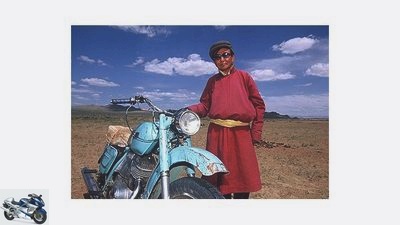
Martin
Encounters like those with the motorcyclist in the Gobi desert are rare.
If it is difficult to drive through China with your own vehicle, a trip to Tibet turns out to be almost impossible. Again it was Li Wenhua who organized the papers for the Autonomous Region of the People’s Republic of China. Unfortunately, this time too, we cannot avoid an official companion who closely observes our every step. But it doesn’t matter. We climb higher and higher, pass the 4000 mark. The thick monsoon clouds have suddenly disappeared and shortly afterwards we are standing on the 5,124 meter high La Lung La Pass. A dream becomes true. We have climbed the Tibetan plateau. In the crystal clear air, the snow-covered eight-thousanders of the Himalayas seem within reach and the high desert of western Tibet spreads out in front of us.
The 5000er passes do not tear off, oxygen-poor air and constant cold are more severe than expected. Headaches plague us for days, and at night we seek the proximity of nomads to warm ourselves in their cattle-fired stoves. At 5200 meters, the BMW finally reaches its limits, because the control electronics can no longer compensate for the lack of oxygen.
The further we go west, the more pilgrims we meet. Thousands are on the way to the holy mountain Kailash on the barren high plateau. After ten days it finally appears on the horizon. Shortly before the Saga Dawa Festival, Buddha’s birthday, the stream of pilgrims simmers towards its climax. We move between tens of thousands of believers who hang up colorful prayer flags under the strict supervision of many monks. Many go on the kora, a 50-kilometer hike around the mountain – 108 circumnavigations secure entry into nirvana. Now, in the year of the horse, each circuit counts thirteen times.
Our visa does not allow any further detours, we drive back to Nepal and look for an air freight forwarding company in Kathmandu to fly our motorcycle to Australia, our next destination.
Related articles
-
On the way Iceland: Departure into the ice deserts
Martin 19th pictures Martin 1/19 Glacier lakes on Vatnajokull. Martin 2/19 Some blocks of ice in the Jokulsarlon glacier lagoon wear black. At the bottom…
-
Zero DSR National Forest Foundation for Earth Day
zero 6th pictures zero 1/6 For its 15th birthday, Zero is bringing a special model with the DSR National Forest Foundation that differs in color from the…
-
Honda NX 650 Dominator: Earth Motorcycles with a fine single tracker
Earth Motorcycles 8th pictures Earth Motorcycles 1/8 Based on a Honda NX 650 Dominator from 1991, Earth Motorcycles build a very fine tracker. Earth…
-
Out and about: Michael Martin Special
Michael Martin 53 pictures Martin 1/53 Of course, that makes Indian men curious. Martin 2/53 … on the most beautiful slopes in the world. Martin 3/53…
-
Photos: Obert to travel South and Central Asia South and Central Asia Around the roof of the world It’s hard to believe, but the idea came spontaneously…
-
archive 22nd pictures archive 1/22 … many Kreidler RS wore expressive golf green. archive 2/22 … One of his first candidates in 1935 was a 600 BSA….
-
to travel Australia Australia Miles and more If you want to get to know the west of Australia, you have to show stamina: the distances between A and B…
-
Andreas Hutter to travel Mongolia Mongolia In the first walk through the steppe An adventurer and photographer from Switzerland sets off on a trip…
-
Schulz to travel Motorcycle world tour Motorcycle world tour 50,000 kilometers home Many dream of the great journey, the trip of a lifetime. At some…
-
Jahn motorcycles At home: everywhere At home: everywhere 25 years of Yamaha Tenere The Yamaha Tenere appeared 25 years ago. For me the whole world became…